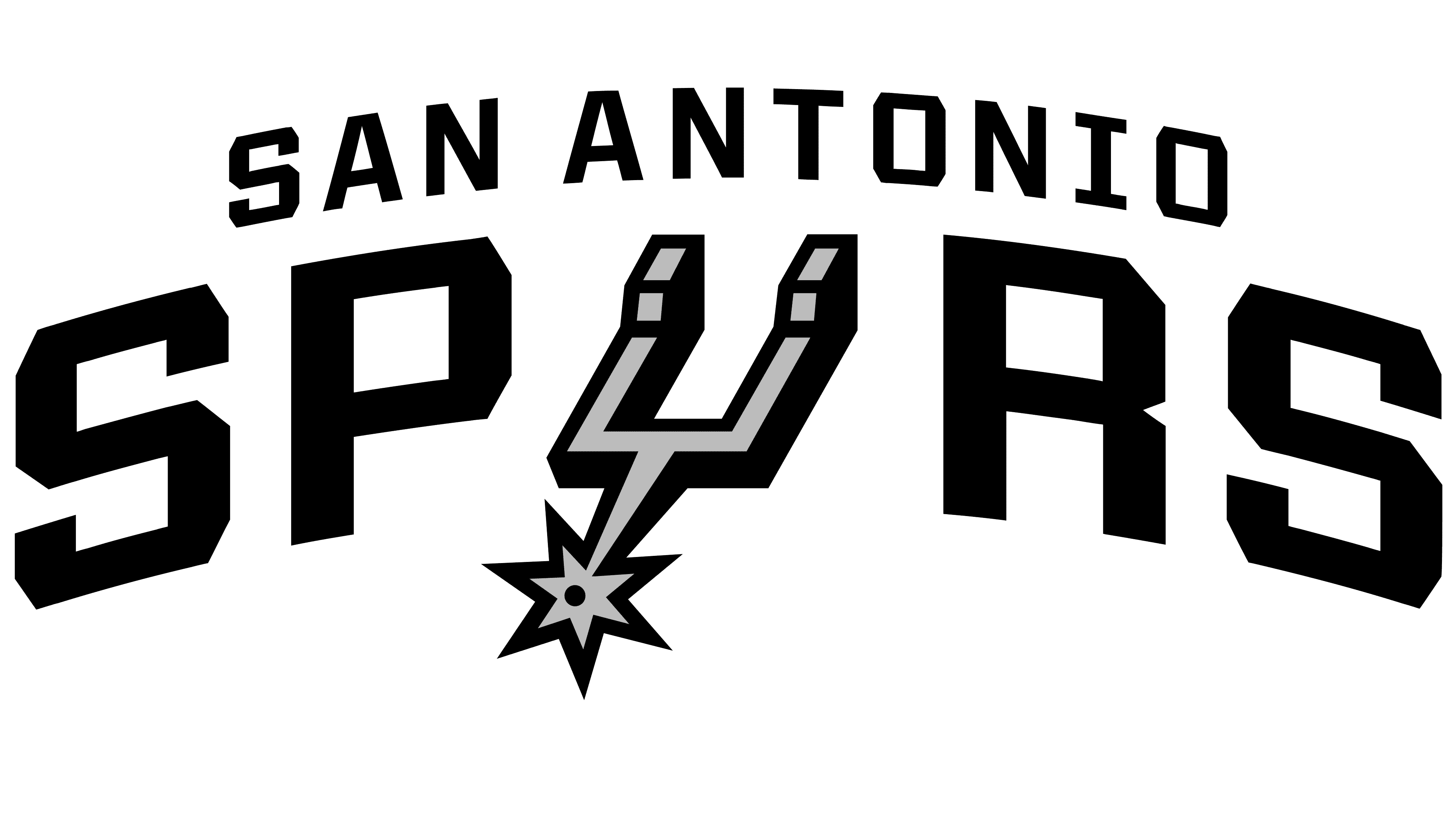San Antonio Spurs Logo
San Antonio Spurs, a pinnacle of consistency and excellence in the NBA, have masterfully blended tradition and innovation. With five championships, guided by legendary coach Gregg Popovich, they revolutionized basketball through their international scouting and selfless team play. Spurs’ dynasty was built around the “Big Three” – Tim Duncan, Manu Ginóbili, and Tony Parker – whose synergy and basketball IQ were unmatched. The team is known for its community connection, embodying the spirit and culture of San Antonio. Despite recent struggles, Spurs’ rich history and commitment to excellence continue to inspire.
Meaning and history
Founded in 1967 as a part of the American Basketball Association (ABA), the San Antonio Spurs have forged an illustrious path in the realms of professional basketball. Initially known as the Dallas Chaparrals, the team relocated to San Antonio in 1973, adopting the “Spurs” moniker, a nod to the city’s rich history in the cowboy and rodeo culture.
The Spurs’ ascent to greatness began in the late ’80s and early ’90s, with the acquisition of David Robinson, whose dominance at the center position propelled the team to new heights. However, it wasn’t until the drafting of Tim Duncan in 1997 that the Spurs solidified their foundation for a dynasty.
Under the guidance of Coach Gregg Popovich, and with the core of Tim Duncan, Tony Parker, and Manu Ginóbili, the Spurs captured five NBA championships (1999, 2003, 2005, 2007, and 2014), defining an era of team-oriented basketball and international scouting acumen.
Their 2014 NBA Finals triumph over the Miami Heat was particularly significant as it was a testament to their beautiful, unselfish style of play, with an emphasis on ball movement and teamwork.
The post-Duncan era has seen the Spurs transition into a new phase. Despite facing challenges in a rapidly evolving NBA landscape, the Spurs’ legacy of excellence, commitment to community, and innovative approach to the game continue to be a beacon of inspiration for teams and fans alike.
As of now, the Spurs are in a rebuilding phase, with a focus on developing young talent and adapting to the modern NBA, all while holding onto the values and principles that have made them one of the most respected and successful franchises in sports history.
1967 – 1970
Prior to 1970, the sports organization went by the name “Dallas Chaparrals,” taking on an emblem that displayed a chaparral bird, awash in hues of blue, in hot pursuit of a basketball colored in rich shades of brown. The chaparral, a species of fast-paced cuckoo boasting an elongated crest and tail, served as the central figure in this artistic portrayal. The designers meticulously focused on capturing the essence and intricacies of this unique bird, highlighting its distinct features and the dynamism that it brings to the team’s visual identity. This emblem not only symbolized the team’s agility and swift playstyle on the court but also paid homage to the region’s native wildlife, embodying the spirit and culture of Dallas in a vibrant and symbolic manner.
1970 – 1971
Upon being renamed the Texas Chaparrals, the team unveiled a reimagined emblem to symbolize this transition. The visual artists infused the logo with a soft pink hue for the ‘CHAPARRALS’ lettering and incorporated a grey geometric form outlined in a stark black, mimicking the silhouette of Texas. This latter element was strategically positioned in the backdrop, while the lettering was placed directly beneath the bird, creating a cohesive and balanced composition. Moreover, the basketball underwent a transformation, adopting a tricolor palette that seamlessly melded red, white, and blue, paying homage to the patriotic colors of the American flag. This meticulous redesign was not merely an aesthetic update; it was a deliberate and thoughtful representation of the team’s evolution and its deep-rooted connection to the state of Texas. The updated logo was a visual testament to the team’s pride in its heritage and its commitment to presenting a unified and powerful identity that resonated with fans and embodied the spirit of the franchise.
1971 – 1973
When the club reverted to its original moniker of Dallas Chaparrals, the emblem underwent only subtle transformations. The state’s silhouette, once a different color, was now painted a stark white, encased within its persistent black border. Simultaneously, the team’s nickname received a touch of elegance as it transitioned to a rich, deep burgundy hue, and the bird, previously depicted in another shade, was given a makeover to a sleek and modern gray. These nuanced changes, while seemingly minor, were strategic, underscoring the team’s commitment to refreshing its visual identity while maintaining a link to its historical roots and legacy. The refreshed logo is a testament to the club’s ability to evolve and adapt while honoring its past, ultimately creating a timeless and iconic emblem that resonates with fans and embodies the spirit of the franchise.
1973 – 1989
This era marked a pivotal transformation in the history of the franchise. With the relocation to San Antonio, there was a deliberate shift to encompass the rich cultural heritage of West Texas, culminating in the decision to adopt the name “Spurs.” This new title acted as a catalyst for the creative minds tasked with crafting the club’s emblem. The outcome was a fresh, contemporary sign that perfectly encapsulated the essence of the San Antonio Spurs as they made their debut in the NBA. The emblem featured an understated, three-dimensional lettering style for the nickname, ingeniously incorporating a riding spur to replace the letter “U.” This innovative design not only aligned with the team’s new identity but also paid homage to the cowboy culture prevalent in West Texas, ultimately producing a visually compelling and meaningful logo that perfectly represented the spirit of the franchise.
1989 – 2002
The year 1990 marked the introduction of an iconic logo, set against a vibrant tri-color backdrop that featured the distinctive “Fiesta colors” of turquoise, orange, and pink, evoking a sense of celebration and cultural richness. While the textual element was retained, subtle yet impactful alterations were made. The name of the city transitioned to a crisp white hue, contrasting beautifully with the club’s nickname, which was rendered in a bold black, outlined meticulously in white. Additionally, the spur underwent a transformation, evolving into a more defined, sharper shape that added a dynamic and modern edge to the overall design. This redesign was not merely aesthetic; it was a deliberate nod to the evolving identity of the club, blending tradition with contemporary elements to create a timeless and visually compelling emblem that resonates with fans and embodies the spirit of the franchise.
2002 – 2017
The colorful Fiesta emblem has transitioned into history, making way for a more refined symbol that harmoniously blends a quartet of hues: the metallic gleam of silver, the depth of black, the neutrality of gray, and the purity of white. While the primary silhouette of the backdrop has been retained, a transformation has occurred at the hands of the designers. They have expertly honed the shape, incorporating precise right angles and distinct borders to lend an air of sophistication. Moreover, the lettering has undergone a metamorphosis, emerging with a gracefully arched silhouette that adds an elegant touch to the overall design. This evolution of the emblem is a testament to the club’s commitment to a progressive identity that pays homage to its past while embracing a modern aesthetic.
2017 – Today
In the year 2017, the basketball franchise took a minimalist approach, securing a new trademark that abandoned the background’s detailed graphics. This simplified emblem features just the “SAN ANTONIO” text in bold black, sitting above the word “SPURS”. In keeping with the club’s iconic style, the letter “U” has been innovatively replaced by a sleek, stylized spur, maintaining the franchise’s unique identity. This streamlined design reflects a modern sensibility while continuing to pay homage to the team’s rich history and cultural connections, encapsulating the spirit of the San Antonio Spurs in a contemporary and visually impactful manner. The new logo encapsulates the evolution of the franchise, symbolizing its forward-looking ethos while remaining true to its roots.


















